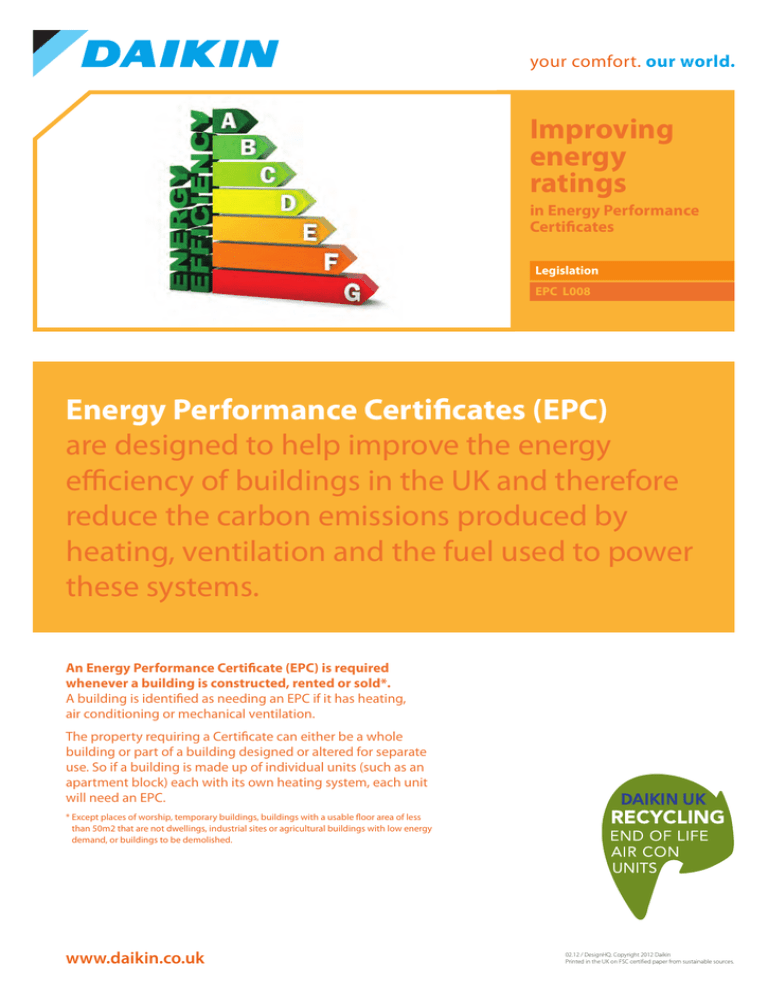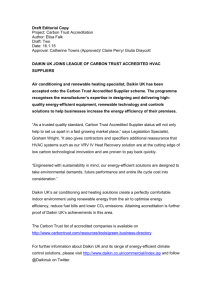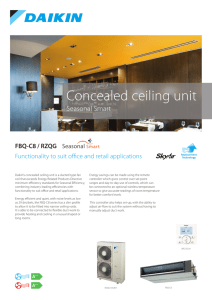Energy Performance Certificates (EPC) are designed to help
advertisement

your comfort. our world. Improving energy ratings in Energy Performance Certificates Legislation EPC L008 Energy Performance Certificates (EPC) are designed to help improve the energy efficiency of buildings in the UK and therefore reduce the carbon emissions produced by heating, ventilation and the fuel used to power these systems. An Energy Performance Certificate (EPC) is required whenever a building is constructed, rented or sold*. A building is identified as needing an EPC if it has heating, air conditioning or mechanical ventilation. The property requiring a Certificate can either be a whole building or part of a building designed or altered for separate use. So if a building is made up of individual units (such as an apartment block) each with its own heating system, each unit will need an EPC. * Except places of worship, temporary buildings, buildings with a usable floor area of less than 50m2 that are not dwellings, industrial sites or agricultural buildings with low energy demand, or buildings to be demolished. www.daikin.co.uk 02.12 / DesignHQ. Copyright 2012 Daikin Printed in the UK on FSC certified paper from sustainable sources. What is an Energy Performance Certificate (EPC)? An Energy Performance Certificate is designed to help improve the energy efficiency of a building. It provides a rating for the energy efficiency, from A (the best) to G (the worst) and must be provided by anyone constructing, refurbishing, renting out or selling a property. The energy efficiency rating reflects the level of fuel bills to be expected at a property. The certificate also includes an environmental rating, which reflects the building’s carbon dioxide emissions. They are produced using standard methods, enabling direct comparisons between buildings of the same type. EPCs are produced by accredited energy assessors who also produce a report which suggests improvements to make a building more energy efficient. The assessor looks at how the building is constructed, insulated, heated, ventilated and the type of fuel being used. For public service buildings, a Display Energy Certificate (DEC) is required instead, which shows the actual energy usage of a building (its Operational Rating) as recorded by gas, electricity and other meters, so that the public can understand the energy efficiency of a building. As its name suggests, the DEC should be displayed on public view. How can a building’s energy performance be improved? How can Daikin Altherma heat pump improve energy ratings? Alongside the EPC is a report that includes recommendations on energy saving measures, what running cost savings these would deliver and how these improvements would change the energy and carbon emission ratings of the property. Similarly, a DEC is also accompanied by an Advisory Report that suggests measures to improve the energy rating of the building. For the domestic heating market, an air-to-water heat pump solution such as the Daikin Altherma LT Split and Monobloc range offers a highefficiency (COPs* of above 3), sustainable home heating and hot water system to replace existing oil or gas boilers. Another way of increasing a building’s rating is the introduction of microgeneration technologies that generate heat from renewable sources, such as an air source heat pump. An air source heat pump extracts energy from the outdoor air and transfers it indoors as heat, delivering up to five times the energy efficiency of traditional fossil fuel systems. Such systems provide major savings on running costs, while avoiding thousands of tonnes of CO2 emissions every year. Air source heat pumps are ideal for both domestic and commercial applications as various system types are available, to suit new build properties and refurbishment projects in place of a traditional gas boiler. The Daikin Altherma HT range has been specially designed to work with existing radiator systems and so is ideally suited for the refurbishment market whilst the low temperature range is perfect for new build properties. In commercial settings, a renewable energy VRV®III heat pump or VRV®III heat recovery system can maximise energy efficiency by using multiple zones on one circuit, delivering year round heating, cooling, ventilation and hot water for small to large-sized offices, hotels and retail environments. Heat recovery systems offer COPs* and EERs of up to 4.3 and 4.1 respectively at 100% connection, exceeding the energy efficiency targets set out by the Government in Part L of the Building Regulations and the rigorous criteria set out by the Enhance Capital Allowance (ECA) qualification. With over 50 years’ experience in the production of heat pumps, manufacturing over a million units a year, Daikin is a world leader in this technology. * COP (Coefficient of Performance). This document is intended for use as a guide to the main issues described. It is not intended to be a statement of law and customers should take legal advice as appropriate. Daikin Airconditioning UK Ltd accept no responsibility for any errors or omissions. Correct at time of print (February 2012).

